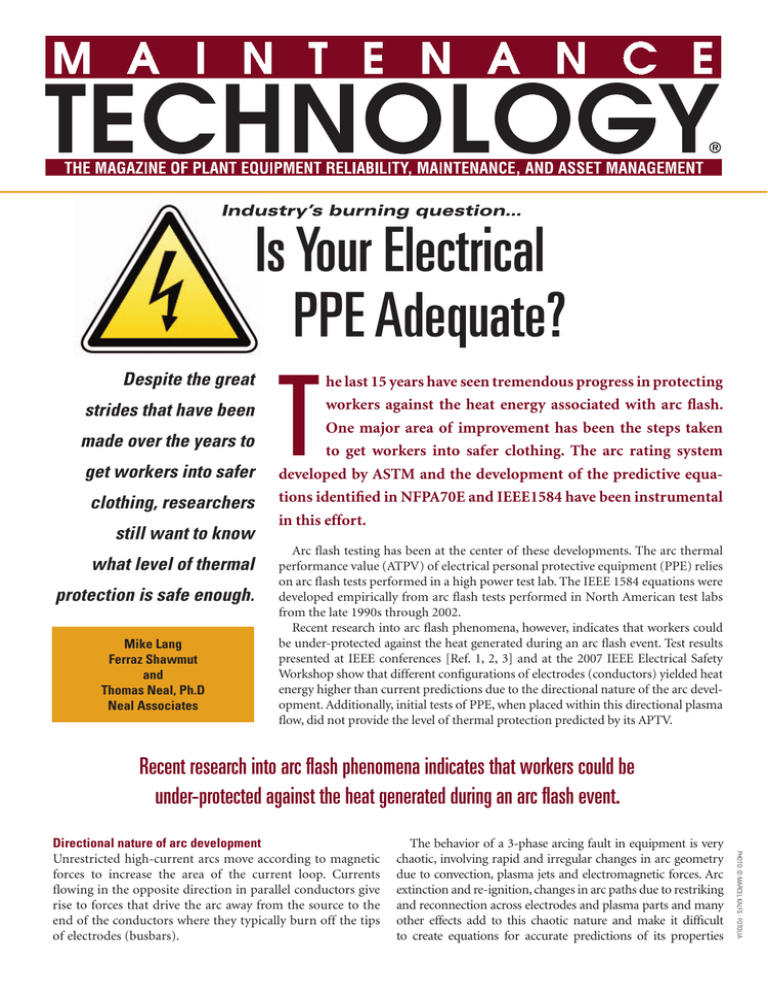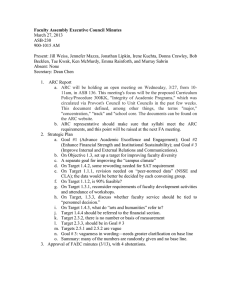
Industry’s burning question…
Is Your Electrical
PPE Adequate?
Despite the great
strides that have been
made over the years to
get workers into safer
clothing, researchers
still want to know
what level of thermal
protection is safe enough.
Mike Lang
Ferraz Shawmut
and
Thomas Neal, Ph.D
Neal Associates
T
he last 15 years have seen tremendous progress in protecting
workers against the heat energy associated with arc flash.
One major area of improvement has been the steps taken
to get workers into safer clothing. The arc rating system
developed by ASTM and the development of the predictive equations identified in NFPA70E and IEEE1584 have been instrumental
in this effort.
Arc flash testing has been at the center of these developments. The arc thermal
performance value (ATPV) of electrical personal protective equipment (PPE) relies
on arc flash tests performed in a high power test lab. The IEEE 1584 equations were
developed empirically from arc flash tests performed in North American test labs
from the late 1990s through 2002.
Recent research into arc flash phenomena, however, indicates that workers could
be under-protected against the heat generated during an arc flash event. Test results
presented at IEEE conferences [Ref. 1, 2, 3] and at the 2007 IEEE Electrical Safety
Workshop show that different configurations of electrodes (conductors) yielded heat
energy higher than current predictions due to the directional nature of the arc development. Additionally, initial tests of PPE, when placed within this directional plasma
flow, did not provide the level of thermal protection predicted by its APTV.
Recent research into arc flash phenomena indicates that workers could be
under-protected against the heat generated during an arc flash event.
The behavior of a 3-phase arcing fault in equipment is very
chaotic, involving rapid and irregular changes in arc geometry
due to convection, plasma jets and electromagnetic forces. Arc
extinction and re-ignition, changes in arc paths due to restriking
and reconnection across electrodes and plasma parts and many
other effects add to this chaotic nature and make it difficult
to create equations for accurate predictions of its properties
PHOTO: © MARCEL KALFS - FOTOLIA
Directional nature of arc development
Unrestricted high-current arcs move according to magnetic
forces to increase the area of the current loop. Currents
flowing in the opposite direction in parallel conductors give
rise to forces that drive the arc away from the source to the
end of the conductors where they typically burn off the tips
of electrodes (busbars).
ELECTRICAL SAFETY
Cloud of hot gas
Plasma “dust”
(CuO smoke)
currents in opposite direction
plasma jets repelled
currents in same direction
plasma jets attracted
molten droplet
shower
Fig. 1. The general directional nature of an arc; this depiction
does not reflect chaotic behavior.
(e.g. impedance). Although it does not capture this chaotic
behavior, Fig. 1 demonstrates an arc’s general directional
nature. The alternating 3-phase current creates successive
attractive and repulsive magnetic forces, dramatically moving
the plasma jets which feed an expanding plasma cloud. The
cloud is driven outward, away from the tips, creating “plasma
dust” as the highly energized molecules in the plasma cool,
then recombine into various materials. The molten electrode
material ejected off the tips also is in this flow.
Arc flash hazards
When the arc is being established, current begins passing
through ionized air, generating massive quantities of heat.
Large volumes of ionized gases, along with metal from the
vaporized conductors, are explosively expelled. As the arc
runs its course, electrical energy continues to be converted
into extremely hazardous energy forms. Hazards include the
immense heat of the plasma, radiated heat, large volumes
of toxic smoke, molten droplets of conductor material,
shrapnel, extremely intense light and a pressure wave from
the rapidly expanding gases.
Recent tests have shown that an object in the expanding
plasma cloud (refer to the red object in Fig. 1) is directly
exposed to the highest heat of the event. Temperatures
greater than 15,000 C have been cited for this area. In
addition to the convective heat transfer from the plasma,
this object is directly exposed to the molten metal
ejected from the electrode tips and radiated heat from
surrounding plasma.
Objects close to the arc but outside of the plasma jets
(refer to the green object in Fig. 1) are not likely subjected
to as high a quantity of heat. Exposure is predominately
radiant heat, but includes convective flow from the thermal
expansion of the gases. Objects in line with the electrodes
but distant from the plasma jets (refer to the blue object
in Fig. 1) receive lower convective heating and less radiant
heat and molten metal spray.
The amount of heat absorbed varies with the method of
heat transfer and receiving surface properties. For example,
the amount of heat transferred from a mass of molten
copper to a surface area would be greater if it adhered to
the object instead of contacting it for a brief time.
Test setups currently used for standards
Although the overriding principle of electrical safety is to
de-energize equipment and place it into an electrically safe
condition prior to work, there are numerous cases where
companies put workers in PPE to perform tasks on energized equipment. The standards typically utilized to predict
the magnitude of heat exposure and the protective ability
of flame resistant (FR) fabric worn by exposed workers are
based upon two unique electrode configurations in their
test procedures. Heat transferred during tests with these
orientations is most likely dominated by radiant heat.
Effects on heat measurements with alternate test
configurations
Research performed at Ferraz Shawmut’s High Power Test
Laboratory has uncovered electrode configurations that
project significantly more heat energy out of enclosures
toward worker locations than currently predicted by the
standards. To simulate components found in low-voltage
electrical equipment, various setups were created for
controlled testing. Heat was measured and compared
with results obtained with the standard configuration
shown in the Sidebar figure on page 36. Results of these
comparisons were published in two recent IEEE papers.
[Ref. 2, 3] Configurations that forced the arc’s plasma
jets outward toward the worker produced heat measurements nearly twice those predicted by current IEEE 1584
equations when studied at typical working distances of
18 inches.
In the barrier configuration setup, the electrodes are
“terminated” into a block of insulating material (barrier)
as shown on the left in Fig. 2. This setup represents conductors connected to equipment from the top, such as the
component shown on right in Fig. 2.
Fig. 2. Barrier test configuration (Left) simulating the line side
connections of the starter (Right)
Equations for
Prediction of Arc
Flash Heat Energy
Density for LowVoltage Applications
■ NFPA 70E. First issued in 1979, NFPA 70E, Standard for
Electrical Safety in the Workplace, is considered the foremost national consensus standard for electrical safety in
public and private places. It covers the full range of electrical safety issues, from work practices to maintenance,
special equipment requirements and installation. The
1995 edition first addressed arc flash hazards with the
addition of “arc flash hazard boundaries,” with the equations based on arcs in open air. “Arc-in-a-box” equations
were added to the 2000 edition as options to calculate a
worker’s potential heat energy density exposure. These
equations came from results of arc flash tests with a steel
box and vertical electrodes with open tips [Ref. 7, 8] as
shown in the photo in this Sidebar. The 2004 edition
added the IEEE 1584 equations below.
■ IEEE 1584. Issued in 2002, IEEE 1584-2002, Guide for
Arc Flash Hazard Calculations, provides guidelines for
an analysis to “identify the flash-protection boundary
and the incident energy at assigned working distances
throughout any position or level in the overall electrical
system.” The results from over 300 arc flash tests were
incorporated into the low-voltage predictive equations
for enclosed equipment contained within IEEE 1584.
Three enclosure sizes were used in these tests, but all tests
also used vertical electrodes with open tips.
■ ASTM 1959. The current edition of ASTM F1959,
Standard Test Method for Determining the Arc Rating
of Materials for Clothing, uses a single phase opposing
electrode orientation. This standard determines the
ATPV rating of material used in arc rated PPE. The test
procedure places materials in locations surrounding the
area where the arc would occur. The majority of the heat
transferred to the material is likely radiated from the arc.
This open air arrangement from the 1980s would simulate flashovers on overhead power systems.
References:
Neal, T.E., Bingham, A.H. and Doughty, R.L. “Protective
Clothing Guidelines for Electric Arc Exposure.” IEEE Transactions on Industry Applications, Vol. 33, No 4, July/August
1997, pgs. 1043-1054
Doughty, R.L., Neal, T.E., and Floyd II, H.L. “Predicting
Incident Energy To Better Manage The Electric Arc Hazard
On 600V Distribution Systems.” Proc IEEE PCIC, Sept.
1998, pgs. 329-346
Fig. 3. (Top) Arc
development
from barrier test
4ms into event,
compared to that
from the vertical
test 3ms into event
(Bottom)
With the barrier in place, the arc’s downward motion
is halted and plasma jets are formed along the plane of
the barrier top surface (i.e. perpendicular to the plane of
the electrode). This significant finding is demonstrated
in Fig. 3. The photo on the top shows a side view of arc
development along the plane of the barrier in a setup
without side panels. This test shows the possibility of
higher convective heat transfer toward workers than the
open vertical setup, shown from the front, on the bottom
in Fig. 3. The barrier configuration also ejected significantly more molten electrode material. [Ref. 3]
Chart 1 compares heat measurements (made with
copper calorimeters) with the barrier setup to standard
predictions. The black line represents predictions of
IEEE 1584 equations for switchgear (20” cubic box) for
the available fault currents with a fixed 6-cycle clearing
time. Alarmingly, the barrier test results almost always
rose above the line—sometimes more than twice the
prediction. All tests with the vertical configuration at this
voltage were at or below the prediction.
Fig. 4. The horizontal test setup was designed to simulate
back-fed equipment like this unit (Left); side view of plasma
flow at 8 milliseconds into a 44kA 600V arcing event for electrodes recessed in the horizontal setup test box (Right)
Another configuration that deserves serious consideration is the “horizontal electrode configuration.” This
setup simulates equipment where bussing is open-ended,
but pointing toward the front of the enclosure, like that
in the equipment shown on the left in Fig. 4. The arc
development, very similar to that described for Fig. 1, is
shown on the right in Fig. 4. Like the barrier configuration, all tests resulted in heat measurements significantly
above the predicted levels.
ELECTRICAL SAFETY
Max Cal/cm2
Barrier Results vs IEEE 1584 Predictions -480V
Fig. 5. Photo of maximum reach of
plasma with current-limiting effect
of 600A UL Class RK1 fuses. Test
conditions are the same as those
described in Fig. 4.
5
10
15
20
25
30
35
Bolted Fault Current (kA)
40
45
50
Chart I. Comparison of barrier results to predictions of IEEE 1584 equations for switchgear. The black line represents prediction; the blue line is 167% of the prediction.
Horizontal Results vs IEEE 1584 Predictions -600V
50.00
45.00
40.00
35.00
Arc Current
Of equal concern is the fact that
arcing currents were below predicted
levels for this configuration (see Chart
II). In some applications, clearing
times will be significantly longer
than expected if the arcing current is
too low to operate the short circuit
element of the upstream overcurrent
protective device (OCPD). In these
applications, the increase in arc flash
heat energies will be far greater than
the differences obtained in tests with
a fixed clearing time of six cycles.
A number of tests with currentlimiting fuses showed, with proper
fuse selection, that workers will
be exposed to far less heat energy
even when standing in locations
subject to the plasma flow (Fig. 5).
The results were very close to those
predicted by current equations.
Plants currently employing this
conservative method of protection
will still need to recalculate arc fault
currents and determine if fuses will
be operating in their current-limiting modes for arc faults on equipment with horizontal electrodes.
20.00
18.00
16.00
14.00
12.00
10.00
8.00
6.00
4.00
2.00
0.00
30.00
25.00
20.00
15.00
10.00
5.00
0.00
5
10
15
Horizontal Test Results
20
25
30
35
Bolted Fault Current (kA)
IEEE1584 (100%)
40
IEEE1584 (85%)
45
50
IEEE1584 (70%)
Chart II. Comparison of arc currents from horizontal tests to predictions of IEEE 1584
equations for switchgear. Note that some of the test results were below even the 85%
value recommended by the standard.
The IEEE/NFPA Arc Flash Collaborative Research Project
The IEEE and NFPA are asking for support to help
fund needed arc flash research.
The combined effort to identify, understand and learn
how to mitigate or protect employees in the workplace
against the potential “electrical arc flash hazards” is
estimated to cost $6-$7M (US). For more information
on this project, log on to: http://standards.ieee.org/esrc/
arcflash/index.html
For more information on ASTM Technical
Committee F18 visit: http://www.astm.org/cgibin/SoftCart.exe/COMMIT/COMMITTEE/F18.
htm?L+mystore+zapd8129
ELECTRICAL SAFETY
Effects of alternate configuration tests on PPE
Preliminary investigations showed that many protective FR
fabrics did not yield the same level of thermal protection
when placed within the directional plasma flow for the
barrier configuration. Tests were performed with FR fabric
placed at 18 inches from the electrodes of the vertical,
barrier and horizontal configurations (see Fig. 6 for fabric
test setup). A variety of currents and clearing times were
used in these 480V tests to generate a range of heat energies
for the tests.
There were surprising results with the barrier and
horizontal tests, as some fabrics performed at only 50%
of their arc ratings. Initial testing of the vertical configuration also indicated that the arc rating of FR fabrics was
reduced. It is suspected that greater heat transfer through
the material because of the increased convective energy
component is responsible for its decreased performance in
the plasma-rich region of the arc. Equally surprising results
were obtained for arc rated faceshields, which exhibited an
increased arc rating. This would be expected since, unlike
the permeable FR fabrics, faceshields are impermeable to
the increased convective energy component.
Moving forward
There are two major areas of improvement for better protection of workers against the heat of arc flash events. Both
areas are related to the possibility that workers could be
directly immersed in the developing plasma flow described
in the foregoing text.
First, equipment configurations that would direct arc
development outward need to be clearly identified and
models developed to better predict the levels of heat
energy that can be presented to workers from arc flashes
in such equipment.
Second, the test method and a modified arc rating
system for PPE need to be developed to address the reduced
Fig. 6 Fabric test setup with barrier test (Left); Front view of
bare and fabric covered calorimeter (Right)
performance of PPE for hazards involving equipment
configurations that would direct the plasma flow outward
toward the worker.
Industry action
Leading organizations concerned with electrical safety are
currently investigating the results of the research outlined in
this article. The IEEE 1584 working group has joined with
the NFPA 70E committee to form the IEEE/NFPA joint
collaborative initiative on arc flash research. The goal of
this research is to provide the information and knowledge
needed to enhance safety standards that predict the hazards
of arc flash events and improve safeguards for workers. The
research and test planning committee has already developed
a comprehensive test protocol to further quantify these
findings and investigate the many other hazards of arcing
events (e.g. pressure waves, sound, toxic smoke).
Additionally, the ASTM F18.65 subcommittee on
Wearing Apparel has formed a task force to further study
the performance of materials in the plasma flow. The task
force will identify any needed modification or additions to
the test protocols of ASTM F 1959F/F1959M-06a for material performance. ❖
Be Careful Out There!
U
ntil the standards provide better
guidance on these configurations,
greater vigilance is necessary.
Review your electrical safety program
and enhance procedures to keep
workers out of energized equipment.
If equipment is suspected to be
similar to the alternate plasma flow
configurations described above, then
consider the rating of protective
clothing to be half the listed arc rating.
When using the NFPA 70E Tables
130.7(C)(9)(A) and 130.7(C)(10) to
select protective clothing and PPE, add
one Hazard Risk Category number to
HRC0, HRC1, HRC2 and HRC3. For
HRC4 hazards, avoid using the Tables
or select PPE with a rating of at least
80 cal/cm2.
Arc flash hazard analysis studies
will be more important than ever. As
better models of arc faults become
available, users will be able to quickly
update and assess situations where
greater hazards will be expected.
For those who have already
completed studies, it is strongly
recommended that you review these
studies and implement projects
to mitigate the hazards wherever
possible. Among other things, actions
could be as simple as:
■ Switching Class H, K and RK-5
fuses to RK-1s. Lower threshold
currents provide the widest range
of current-limiting operation
and lowest energies. Tests with all
configurations yielded results of 0.5
cal/cm2 or less when fuses operated
in their current-limiting modes.
■ Reducing Circuit Breaker Settings.
Where advantageous, lower pickup settings to ensure that arc
fault currents will operate circuit
breakers in their instantaneous
modes.
For other suggestions visit
us.ferrazshawmut.com/arcflashinfo
ELECTRICAL SAFETY
References:
1. Stokes, A.D. and Sweeting, D.K. “Electric Arcing Burn
Hazards”, IEEE PCIC Conference Record, 2004. Paper
PCIC-2004-39, 9 pgs
2. Wilkins, R., Allison, M. and Lang, M. “Effect of Electrode
Orientation in Arc Flash Testing”, IEEE Industry Applications Conference, 40th IAS Annual Meeting, Hong Kong,
2-6 October 2005, pgs. 459-465
3. Wilkins, R., Lang, M. and Allison, M. “Effect Of Insulating Barriers In Arc Flash Testing” IEEE PCIC Conference Record, 2006. Paper PCIC-2006-6, 6 pgs.
4. Standard for Electrical Safety in the Workplace, NFPA
70E, 2004 Edition. National Fire Protection Association
Mike Lang works with Ferraz Shawmut, in Roswell, GA.
In his 14 years with the company he’s held various field
engineering positions and currently serves as manager of
field engineering. A team leader on the IEEE 1584 working
group, Lang participated on the IEEE/NFPA RTPC. Ferraz
Shawmut is a platinum-level sponsor of the IEEE/NFPA Arc
Flash Collaborative Research and Testing Project. E-mail:
Mike.LANG@ferrazshawmut.com
Dr. Thomas E. Neal is principal consultant for Neal Associates
Ltd. An IEEE senior member, Neal is vice-chair of the ASTM
F23 Committee on Protective Clothing, chair of the ASTM
E54.04 Homeland Security Subcommittee on PPE and leader
of three ASTM F18 Task Groups for Arc Resistant Protective
Clothing and Equipment.
5. IEEE Guide for Performing Arc-Flash Hazard Calculations. IEEE Standard 1584, IEEE, September 2002
6. ASTM F1959/F1959M-06a Standard Test Method for
Determining the Arc Rating of Materials for Clothing
Reprinted with permission from Maintenance Technology, May 2007.
© APPLIED TECHNOLOGY. All Rights Reserved. On the Web at www.maintenancetechnology.com.
374 Merrimac Street
Newburyport, MA 01950
P 978-462-6662
F 978-462-0181
us.ferrazshawmut.com



